Allison Katz’s first solo exhibition with Hauser & Wirth is on view at their newest gallery in West Hollywood. The title Westward, Ho! bears a double meaning. The obvious one is a commentary on the inescapable world of Hollywood. The other recalls the unraveling of American Manifest Destiny. Westward, Ho! is a chronicle of American mythmaking. The press release notes that Katz visited and drew inspiration from the ruins of Pompeii. Interestingly though, the ruined cultures of the pre-Columbian American continent are nowhere to be found – an erasure that is foundational to the stories that Americans tell themselves. The most prominent motif on display here is Katz’s use of framing. Many of the paintings are encased by framed fields of vision. On the surface, the frames add an occasionally whimsical, sometimes baroque layer to the paintings. They also add layers of mediation between the viewer and the focal images of the canvas. This mediation is a central technique in the processes of American mythmaking. Whether it is a fashion advertisement, a tourist brochure, or a history textbook, ideas about how to look, where to go, and what exactly makes this place “America” are meticulously constructed and mediated through apparatuses that blend and shapeshift until they are cemented as “culture.”
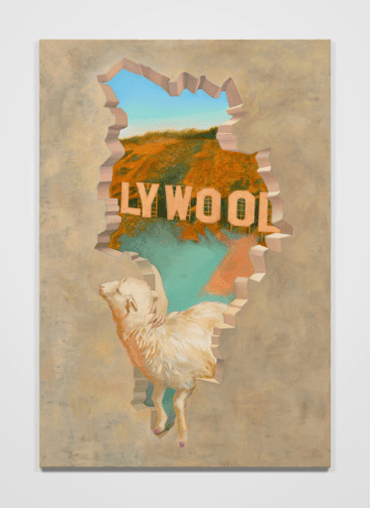
Oil on linen
220 x 150.5 x 3.8 cm / 86 ⅝ x 59 ¼ x 1 ½ in
Photo: Keith Lubow
© Allison Katz
Courtesy the artist and Hauser & Wirth
See Katz’s road painting, a riff on the American road genre. It is both an open and a closed painting. It is open in the sense that the road could lead anywhere. The possibilities feel endless. It is closed in the sense that it centralizes the road itself, depicting very little else. While I see the painting as a riff on the American road genre, this doesn’t pull from the visions of the road that one would find in narratives of hyper-masculinity like Easy Rider or On the Road. In those narratives, the road is a vessel that allows the characters to lay their cultural imprint on one American landscape to the next. Katz’s road, though, is the essence of the painting. Its windiness and glow make it appear to be a harbinger of American mythical power. This road, as in most American road narratives, obscures the rich histories of the land that they traverse while establishing the exhibition as one couched in a specific kind of fossil-fueled modernity. This centralization of the road performs the work of directly reminding us that the road is the building block of American identity. One motto of Manifest Destiny was “Westward, Ho” and American roads and freeways are the material realizations of that motto.
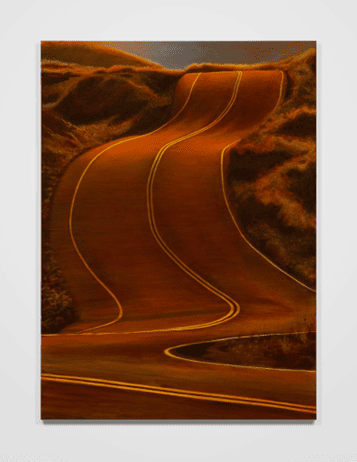
Acrylic on linen
220 x 160 x 3.6 cm / 86 ⅝ x 63 x ⅓ in
Photo: Keith Lubow
© Allison Katz
Courtesy the artist and Hauser & Wirth
This exploration of the road continues with an example of cultural consciousness. A painting that is facetiously titled “Don’t A.S.K” shows two chickens trotting across a road. The question that immediately popped into my mind – “why did the chicken cross the road?” It’s a humorous one, but it is a simple example of a question that, so often asked as part of a joke, will likely be known by most viewers who see the painting. Katz’s ironic title is likely a nod to that knowledge. This painting, unlike “Rear,” is framed by a vibrant blend of blue and orange. It is a meta kind of frame here, as we might note that cultural images of chickens on roads are so often “framed” by the cultural context of humor.
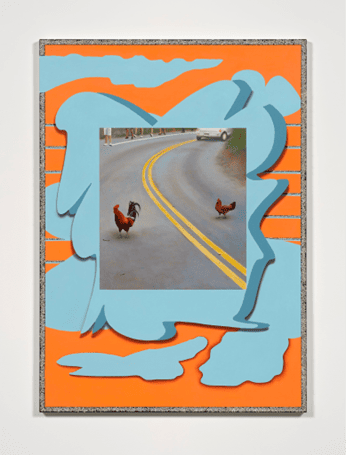
Oil and rice on linen
175 x 125 x 3.6 cm / 68 ⅞ x 49 ¼ x 1 ⅜ in
Photo: Keith Lubow
© Allison Katz
Courtesy the artist and Hauser & Wirth
Katz is interested in this multi-dimensional way of thinking about frames. This is evidenced by paintings that explore the mediation of inside and outside spaces. One painting, titled “Eternity,” was particularly striking to my eye. She stages the perspective of the painting to appear from inside a room. In the center of the canvas, we see two men – only one of them is prominently featured – placing a window into an open space. Upon first look, my eye immediately went to the central figure and the red-framed window. Further glances, though, had me fascinated with the surrounding contexts. The room that the painterly perspective gazes from is obscure. To the left and towards the top, two black shapes emerge but what they are is unclear. This painting, like the sheepish Hollywood painting, implies a liminal statement. Our view of the outside is obscured by the frames of the building and the window, while our view of the inside is obscured by perspective. “Eternity” comments on the limiting powers of framing devices — perhaps a continuation of American mythmaking’s tendency to limit how we view history.
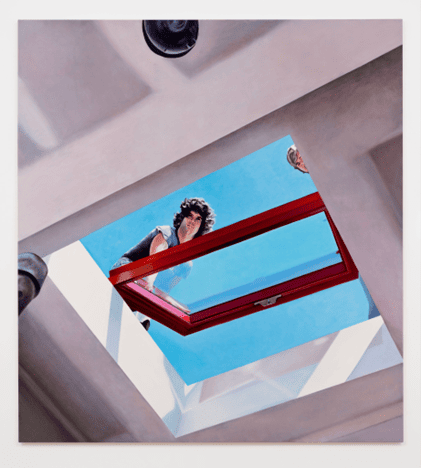
Oil on canvas
220 x 200 x 3.6 cm / 86 ⅝ x 78 ¾ x 1 ⅜ in
Photo: Damian Griffiths
© Allison Katz
Courtesy the artist and Hauser & Wirth
Windows show up in two more paintings to further illuminate the mediation of indoor and outdoor space. Crucially, the exhibition obscures the lines between abstraction and realism. One painting interrogates shifting perspectives by turning to Venice Beach, an appropriately mythical Los Angeles icon. Central to the painting is a slightly distanced view of buildings that float along the ocean’s edge. That portion of the painting is relatively traditional, and if not for the title, one would be forgiven for thinking that it’s just any old beach town. The frame, however, dislodges the painting from reality. A woman dots each corner of the wonky surroundings. They are positioned in a way that makes them appear to be holding each corner. It is as if they exist in an absurd netherworld, and have stretched open a portal onto the one that many of us feel used to. Of course, the frame positions us from their world, troubling our conceptions of absurdity and reality.
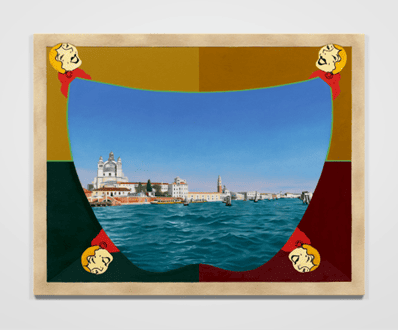
Oil and sand on canvas
150.5 x 190.8 x 3.8 cm / 59 ¼ x 75 ⅛ x 1 ½ in
Photo: Keith Lubow
© Allison Katz
Courtesy the artist and Hauser & Wirth
The exhibition’s major triptych pivots exclusively to an outside perspective. “Responding” is a stylistic departure that leans toward romanticism. Large creatures surround two murky human silhouettes. The triptych is dreamlike, but the silhouettes seem to be the least significant piece of them – if they are in a dream, it isn’t their dream. A zoomed-out argument can be made that the colors and creatures are the frames of this triptych. The paintings suggest that natural earthly surroundings remain the most enduring frame of human culture. Notably, the creatures are often unseen, fast-moving creatures, not everyday sidewalk animals like cats, squirrels, or raccoons. The three separated canvasses provide a natural fragmentation to the world of the triptych. Not only do the silhouettes represent a fragmented relationship between humans and nature, but they remind us that fragmentation is also damaging to natural habitats. These unseen creatures, like the often hidden premodern histories of the continent, underlie Katz’s work. They elucidate the dimensions that make up modern identity, cultural perspectives, and the mythical dimensions humans use to craft narratives and images. Viewers will rightly be interested in Katz’s own personal explorations, formal experiments, and negotiations with popular culture, but they shouldn’t forget about the dimensions that lay below the surface.

Acrylic on canvas
3 parts, each: 300 x 130 x 3.6 cm / 118 ⅛ x 51 ⅛ x 1 ⅜ in
Photo: Damian Griffiths
© Allison Katz
Courtesy the artist and Hauser & Wirth
Westward, Ho! is on view at Hauser & Wirth West Hollywood through January 20th, 2024.